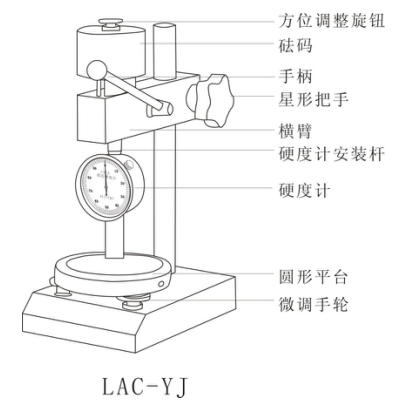I. Performance Introduction
LAC-YJ and LD-YJ test stands are new-generation Shore hardness test stands developed by our company. They use high-quality black marble as the base and high-strength refined tempered glass as the test platform, making the test more stable and the measurement results more accurate. Reasonable structure and beautiful style.
LAC-YJ is suitable for LX-A and LX-C hardness testers produced by our company, and LD-YJ is suitable for LX-D hardness testers produced by our company.
Second, the name and function of each component


①Handle: apply force to the measured object when measuring the object.
② Star handle: Adjust the height of the cross arm.
Third, use
1. Installation and commissioning:
⑴The test stand should be placed on a stable and flat workbench, and then adjust the height of the cross arm. During operation, loosen the star-shaped handle with your right hand, and lift the horizontal arm with your left hand to make the bottom of the hardness tester mounting rod about 110mm away from the circular platform. Tighten the star-shaped handle (the hardness tester mounting rod should be aligned with the center of the circular platform).
旋 Unscrew the dust cap on the upper end of the hardness tester, and then screw the hardness tester into the mounting bar of the test frame, and tighten it (do not use force when tightening, otherwise the hardness tester will be damaged). The operator can loosen the azimuth adjustment knob on the top of the weight, then turn the hardness tester to the desired angle, and then tighten the azimuth adjustment knob.
(3) Loosen the star handle on the cross arm, adjust the height of the cross arm again with your left hand, and tighten the star handle when the bottom surface of the hardness tester foot is about 15mm from the round platform of the test stand. Place the hardness block at the center of the circular table, press down the handle of the test frame, so that the presser foot is completely in contact with the plane of the hardness block, and slowly turn the two fine-tuning hand wheels under the circular table until the hardness meter shows 100 degrees (± 1 Degrees), remove the hardness block after adjustment. At this point, the installation and commissioning of the test frame and hardness tester are finished.
2. Sample requirements:
The specimen must be flat, with a thickness of not less than 6 mm, and a sufficient area, and the contact position between the pressure pin and the specimen shall be not less than 12 mm from the edge of the specimen.
3. Test method for hardness of rubber and plastic samples:
Place the sample on the round platform, loosen the star handle on the cross arm, adjust the height of the cross arm, until the bottom surface of the hardness tester foot is about 5mm from the test surface of the sample, and tighten the star handle on the cross arm. Press down the handle to make the hardness meter read within 1 second when the pressure foot and the sample are fully in contact with the weight of the fixed load. The value displayed by the hardness meter is the hardness value of the test sample. In order to improve the accuracy of the test, five measurements were taken at different positions at a distance of at least 6 mm from each other and the average value was obtained.
Fourth, maintenance
Lubricant should be frequently filled in each moving part of the test frame. After the test, the instrument should be cleaned to prevent moisture and coated with a small amount of anti-rust oil.